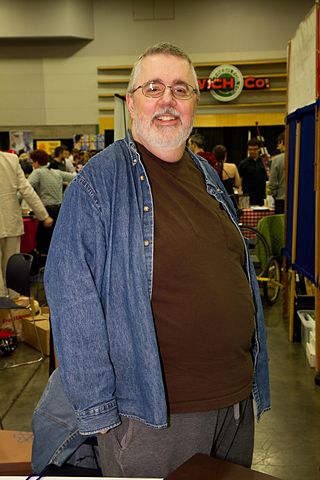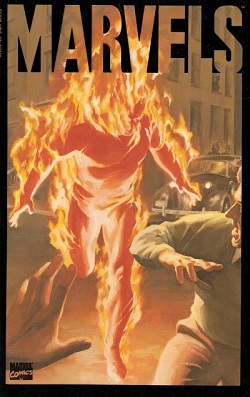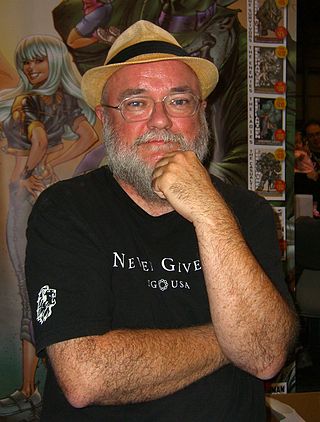
Scott McCloud is an American cartoonist and comics theorist. He is best known for his non-fiction books about comics: Understanding Comics (1993), Reinventing Comics (2000), and Making Comics (2006), all of which also use the medium of comics.
William Douglas Oakley was a letterer for numerous comic books from Marvel, DC, and other companies. His most prominent works include the first two volumes of Alan Moore and Kevin O'Neill's The League of Extraordinary Gentlemen and Batman: Gotham Knights #1-11, #15-37.
A letterer is a member of a team of comic book creators responsible for drawing the comic book's text. The letterer's use of typefaces, calligraphy, letter size, and layout all contribute to the impact of the comic. The letterer crafts the comic's "display lettering": the story title lettering and other special captions and credits that usually appear on a story's first page. The letterer also writes the letters in the word balloons and draws in sound effects. Many letterers also design logos for the comic book company's various titles.

Kurt Busiek is an American comic book writer. His work includes the Marvels limited series, his own series titled Astro City, a four-year run on The Avengers, Thunderbolts and Superman.

Nelson Alexander Ross is an American comic book writer and artist known primarily for his painted interiors, covers, and design work. He first became known with the 1994 miniseries Marvels, on which he collaborated with writer Kurt Busiek for Marvel Comics. He has since done a variety of projects for both Marvel and DC Comics, such as the 1996 miniseries Kingdom Come, which Ross co-wrote. Since then he has done covers and character designs for Busiek's series Astro City, and various projects for Dynamite Entertainment. His feature film work includes concept and narrative art for Spider-Man and Spider-Man 2, and DVD packaging art for the M. Night Shyamalan film Unbreakable. He has done covers for TV Guide, promotional artwork for the Academy Awards, posters and packaging design for video games, and his renditions of superheroes have been merchandised as action figures.

Todd Klein is an American comic book letterer, logo designer, and occasional writer, primarily for DC Comics.

Marvels is a four-issue miniseries comic book written by Kurt Busiek, painted by Alex Ross and edited by Marcus McLaurin. It was published by Marvel Comics in 1994.

Timothy Roger Sale was an American comics artist, "best known for his work on the DC Comics characters Batman and Superman and for influencing depictions of the Caped Crusader in numerous films." He is primarily known for his collaborations with writer Jeph Loeb, which included both comics work and artwork for the TV series Heroes. Sale's renditions of Batman influenced modern cinematic depictions of the character, with film directors and actors directly citing Sale's work.

Richard Starkings is a British font designer and comic book letterer, editor and writer. He was one of the early pioneers of computer-based comic-book lettering, and is one of the most prolific creators in that industry.

Darwyn Cooke was a Canadian comics artist, writer, cartoonist, and animator who worked on the comic books Catwoman, DC: The New Frontier, The Spirit and Richard Stark's Parker: The Hunter. His work has been honoured with numerous Eisner, Harvey, and Joe Shuster Awards.

General Thaddeus E. "Thunderbolt" Ross is a fictional character who appears in comic books published by Marvel Comics featuring the Hulk. Ross is a United States military officer, the father of Betty Ross, ex-father-in-law of Glenn Talbot, father-in-law of Bruce Banner, and the head of the gamma bomb project that turned Banner into the Hulk. After the creation of the Hulk, Ross pursues the creature with a growing obsession, and, after learning that Banner and the Hulk are one and the same, Ross hunts Banner as well. In 2008, Ross was transformed into the Red Hulk to better combat his nemesis.

Ian Churchill is a British comic book artist, who has mostly worked in the American comic book industry.

Mark Chiarello is an American illustrator, art director and comic book editor. Born on Halloween in 1960, he attended Pratt Institute in the 1980's.

Chris Eliopoulos is an American cartoonist and letterer of comic books.

Steve Lieber is an American comic book illustrator known for his work on books such as Detective Comics and Hawkman, and the critically acclaimed miniseries Whiteout, which was adapted into a 2009 feature film starring Kate Beckinsale. His other works include the Eisner Award-winning sequel Whiteout: Melt, and the thrillers Shooters and Underground. With writer Nat Gertler, he co-authored The Complete Idiot's Guide to Creating a Graphic Novel.

John Workman is an American editor, writer, artist, designer, colorist and letterer in the comic book industry. He is known for his frequent partnerships with writer/artist Walter Simonson and also for lettering the entire run of Grant Morrison/Rachel Pollack's Doom Patrol.
Thomas Orzechowski is a comic book letterer, primarily known for his work on Uncanny X-Men. Over the course of Orzechowski's career, he has lettered something on the order of 6,000 pages of Chris Claremont's scripts.
Ken Lopez is a letterer and logo designer for the comic book industry. A pioneer of computer lettering, Lopez designed the fonts for DC Comics's in-house lettering unit, and is currently DC's art director for lettering and its cover editor.
The Comics Buyer's Guide (CBG) magazine administered the annual Comics Buyer's Guide Fan Awards from 1982 to circa 2010, with the first awards announced in issue #500.













